The Design of Concrete Beams Reinforced with GFRP Bars Based on Crack Width
Abstract
:1. Introduction
2. The Concrete Compressive Strain at the Extreme Compression Fiber of Concrete under the Design Limit State
3. Experimental Program
3.1. Specimens
3.2. Materials
3.3. Instrumentation and Testing
4. Finite Element
4.1. Material Model
4.2. Bond–Slip Model
4.3. Cracking Model
4.4. Boundary, Element, and Mesh
4.5. Verification of the FEM Results
5. Results and Analysis
6. Design of GFRP-RC Beams
6.1. Equivalent Rectangular Stress Block Coefficient under the Design Limit State
6.2. The Longitudinal Reinforcement Ratio in the Tensile Zone
6.3. The Ultimate Limit State
7. The Comparison between Theoretical Calculations and Experimental Results
7.1. The Design Limit State
7.2. The Ultimate Limit State
8. Flexural Capacity Coefficient
9. Conclusions
- (1)
- If the longitudinal reinforcement ratio is greater than the balanced reinforcement ratio, when the flexure crack width of the GFRP-RC beam reaches the standard limit value of 0.5 mm, the concrete compressive strain at the extreme compression fiber of the concrete is about 0.001. The longitudinal reinforcement ratio, concrete strength, and longitudinal reinforcement arrangement have little influence on the concrete compressive strain of this state.
- (2)
- Great changes take place in the stress–strain relation of GFRP-RC beams under the design limit state and the ultimate limit state. By setting the concrete compressive strain at the extreme compression fiber of concrete as 0.001, the equivalent rectangular stress block coefficient, the depth of the concrete compressive zone, and the strain of the tensile bar are calculated again. Finally, a formula for the calculation of the longitudinal reinforcement ratio under this state was derived.
- (3)
- The theoretical bending moment under the design limit state was compared with its experimental value. The ratio between them ranges from 0.92 to 1.04. Their good agreement proves that the calculation in this paper is correct.
- (4)
- When the concrete of the test beams in the compressive zone is crushed under the ultimate limit state, the concrete crack width in the tensile zone reaches 1.2–2.0 mm, far beyond the standard limiting value of 0.5 mm, which explains further that it is appropriate to treat the moment when the concrete crack width in the tensile zone reaches the limiting value as the design limit state, reasonably reflecting the property of the GFRP bar and the actual working conditions of the beam. Furthermore, the ratio between the theoretical and experimental flexural bending moments under the ultimate limit state ranges from 0.85 to 0.96, and hence it is in a good agreement.
- (5)
- GFRP-RC beams based on the design method proposed in this paper have the flexural capacity coefficient of about 2.5, which means the beams have a very high factor of safety and reserve strength. Generally, the stress of the tensile bar material is no more than 30% of the ultimate strength, which makes it safe against creep failure too, thereby ensuring its long-term performance.
Author Contributions
Funding
Institutional Review Board Statement
Informed Consent Statement
Data Availability Statement
Acknowledgments
Conflicts of Interest
List of Notations
| αd and βd are the strain-dependent parameter and stress-dependent parameter under the design limit state, respectively. |
| αu and βu are the strain-dependent parameter and stress-dependent parameter under the ultimate limit state, respectively. |
| εcd and fcd are the concrete compressive strain and stress under the design limit state, respectively. |
| εfd and ffd are the tensile strain and stress of the GFRP bar under the design limit state, respectively. |
| εcu and fcu are the concrete compressive strain and stress under the ultimate limit state, respectively. |
| εfl and ffl are the tensile strain and stress of the GFRP bar under the ultimate limit state, respectively. |
| xcd is the height of the concrete compression zone under the design limit state. |
| xcu is the height of the concrete compression zone under the ultimate limit state. |
| εfu is the ultimate tensile strain of the GFRP bar. |
| ffu is the ultimate tensile strength of the GFRP bar. |
| Ef is the modulus of elasticity in tension of the GFRP bar. |
| fc is the concrete strength. |
| ρfb is the balanced reinforcement ratio. |
| ρf is the longitudinal reinforcement ratio of the tensile GFRP bar in test specimens. |
| ρd is the longitudinal reinforcement ratio of the tensile GFRP bar under the design limit state. |
| Wd,ex is the experimental value of the maximum flexure crack width. |
| Pd,ex is the experimental value of the applied load under the design limit state. |
| Md,ex is the experimental bending moment under the design limit state. |
| Md,th is the theoretical bending moment under the design limit state. |
| Wu,ex is the experimental value of the maximum flexure crack width under the ultimate limit state. |
| Pu,ex is the applied load under the ultimate limit state. |
| Mu,ex is the experimental bending moment under the ultimate limit state. |
| Mu,th is the theoretical bending moment under the ultimate limit state. |
| b is the width of the beam section. |
| h is the height of the beam section. |
| h0f is the effective height of the beam section. |
References
- GB50608-2010; Technical Code for Infrastructure Application of FRP Composites. Ministry of Housing and Urban-Rural Development of the People’s Republic of China; China Planning Press: Beijing, China, 2011. (In Chinese)
- Nanni, A.; Luca, D.; Zadeh, H. Reinforced Concrete with FRP Bars: Mechanics and Design; CRC Press: New York, NY, USA, 2014. [Google Scholar]
- Zhang, S.; Yang, D.; Sheng, Y.; Garrity, S.; Xu, L. Numerical modelling of FRP-reinforced masonry walls under in-plane seismic loading. Constr. Build. Mater. 2017, 134, 649–663. [Google Scholar] [CrossRef]
- Zhu, H.; Cheng, S.; Gao, D.; Neaz, S.; Li, C. Flexural behavior of partially fiber-reinforced high-strength concrete beams reinforced with FRP bars. Constr. Build. Mater. 2018, 161, 587–597. [Google Scholar] [CrossRef]
- Kytimou, V.; Kosmidou, P.; Chalioris, C. Numerical Analysis Exterior RC Beam-Column Joints with CFRP Bars as Beam’s Tensional Reinforcement under Cyclic Reversal Deformations. Appl. Sci. 2022, 12, 7419. [Google Scholar] [CrossRef]
- EI-Mandouh, M.; Omar, M.; EInaggar, M.; Abd El-Maula, A. Cyclic behavior of high-strength lightweight concrete exterior beam-column connections reinforced with GFRP. Buildings 2022, 12, 179. [Google Scholar] [CrossRef]
- Barris, C.; Torres, L.; Vilanova, I.; Mias, C.; Llorens, M. Experimental study on crack width and crack spacing for Glass-FRP reinforced concrete beams. Eng. Struct. 2017, 131, 231–242. [Google Scholar] [CrossRef]
- Xue, W.; Peng, F.; Zheng, Q. Design Equations for Flexural Capacity of Concrete Beams Reinforced with Glass Fiber–Reinforced Polymer Bars. J. Compos. Constr. 2016, 20, 04015069. [Google Scholar] [CrossRef]
- Barris, C.; Torres, L.; Mias, C.; Vilanova, I. Design of FRP reinforced concrete beams for serviceability requirements. J. Civ. Eng. Manag. 2012, 18, 843–857. [Google Scholar] [CrossRef]
- Torres, L.; Neocleous, K.; Pilakoutas, K. Design procedure and simplified equations for the flexural capacity of concrete members reinforced with fibre-reinforced polymer bars. Struct. Concr. 2012, 13, 119–129. [Google Scholar] [CrossRef]
- Mostafa, E. Behaviour of Continuous Concrete Beams Reinforced with FRP Bars. Master’s Thesis, University of Manitoba, Winnipeg, MB, Canada, 2011. [Google Scholar]
- CAN/CSA S806-12; Design and Construction of Building Components with Fiber Reinforced Polymers. Canadian Standards Association (CSA): Toronto, ON, Canada, 2012.
- ACI 440.1R 06; Guide for the Design and Construction of Concrete Reinforced with FRP Bars. American Concrete Institute (ACI): Farmington Hills, MI, USA, 2006.
- ISIS Manual 03-07; Design Manual No.3: Reinforcing Concrete Structures with Fiber Reinforced Polymers. ISIS Canada: Winnipeg, MB, Canada, 2007.
- CAN/CSA-S6; Canadian Highway Bridge Design Code. Canadian Standards Association (CSA): Toronto, ON, Canada, 2006.
- JSCE-1997; Recommendation for Design and Construction of Concrete Structures Using Continuous Fiber Reinforcing Materials. Japan Society of Civil Engineering: Tokyo, Japan, 1997.
- CNR-DT 203/2006; Guide for the Design and Construction of Concrete Structures Reinforced with Fiber-Reinforced Polymer Bars. Advisory Committee on Technical Recommendations for Construction: Rome, Italy, 2006.
- Murthy, A.R.; Pukazhendhi, D.M.; Vishnuvardhan, S.; Saravanan, M.; Gandhi, P. Performance of concrete beams reinforced with GFRP bars under monotonic loading. Structures 2020, 27, 1274–1288. [Google Scholar] [CrossRef]
- Murad, Y.; Tarawneh, A.; Arar, F.; Al-Zu, A.; Al-Ghwairi, A.; Al-Jaafreh, A.; Tarawneh, M. Flexural strength prediction for concrete beams reinforced with FRP bars using gene expression programming. Structures 2021, 33, 3163–3172. [Google Scholar] [CrossRef]
- Getzlaf, D. An Investigation into the Flexural Behaviour of GFRP Reinforced Concrete Beams. Master’s Thesis, University of Toronto, Toronto, ON, Canada, 2012. [Google Scholar]
- El-Nemr, A.; Ahmed, E.; Benmokrane, B. Flexural behavior and serviceability of normal- and high-strength concrete beams reinforced with glass fiber reinforced polymer bars. ACI Struct. J. 2013, 110, 1077–1088. [Google Scholar]
- Miàs, C.; Torres, L.; Guadagnini, M.; Turon, A. Short and long-term cracking behaviour of GFRP reinforced concrete beams. Compos. Part B—Eng. 2015, 77, 223–231. [Google Scholar] [CrossRef]
- El-Nemr, A.; Ahmed, E.; Barris, C.; Benmokrane, B. Bond-dependent coefficient of glass- and carbon-FRP bars in normal- and high-strength concretes. Constr. Build. Mater. 2016, 113, 77–89. [Google Scholar] [CrossRef]
- ACI 440.1R 15; Guide for the Design and Construction of Concrete Reinforced with FRP Bars. American Concrete Institute (ACI): Farmington Hills, MI, USA, 2015.
- Kazemi, M.; Li, J.; Lahouti Harehdasht, S.; Yousefieh, N.; Jahandari, S.; Saberian, M. Nonlinear behaviour of concrete beams reinforced with GFRP and CFRP bars grouted in sleeves. Structures 2020, 23, 87–102. [Google Scholar] [CrossRef]
- GB50010-2010; Code for Design of Concrete Structures. Ministry of Housing and Urban-Rural Development of the People’s Republic of China; China Architecture and Building Press: Beijing, China, 2010. (In Chinese)
- Gao, K.; Xie, H.; Li, Z.; Zhang, J.; Tu, J. Study on eccentric behavior and serviceability performance of slender rectangular concrete columns reinforced with gfrp bars. Compos Struct. 2021, 263, 113680. [Google Scholar] [CrossRef]
- Rodacki, K.; Furtak, K. Numerical analysis of crack development of timber-glass composite i-beams in the extended finite element method (xfem). Compos Struct. 2019, 209, 349–361. [Google Scholar] [CrossRef]
- Jin, H.; Yu, S. Study on corrosion-induced cracks for the concrete with transverse cracks using an improved cdm-xfem. Constr. Build. Mater. 2022, 318, 126173. [Google Scholar] [CrossRef]
- Dassault Systèmes. Analysis Users’s Guide; ABAQUS 6.14; Volume IV: Elements; Dassault Systèmes: Velizy-Villacoublay, France, 2013. [Google Scholar]
- Emmons, P.; Vaysburd, A.; Thomas, J. Strengthening Concrete Structures, Part II. Concr. Int. 1998, 20, 56–60. [Google Scholar]
- Mufti, A.; Newhook, J.; Tadros, G. Deformability versus ductility in concrete beams with FRP reinforcement. In Proceedings of the 2nd International Conference on Advanced Composite Materials in Bridges and Structures, Montreal, QC, Canada, 11–14 August 1996; CSCE: Montreal, QC, Canada, 1996; pp. 189–199. [Google Scholar]
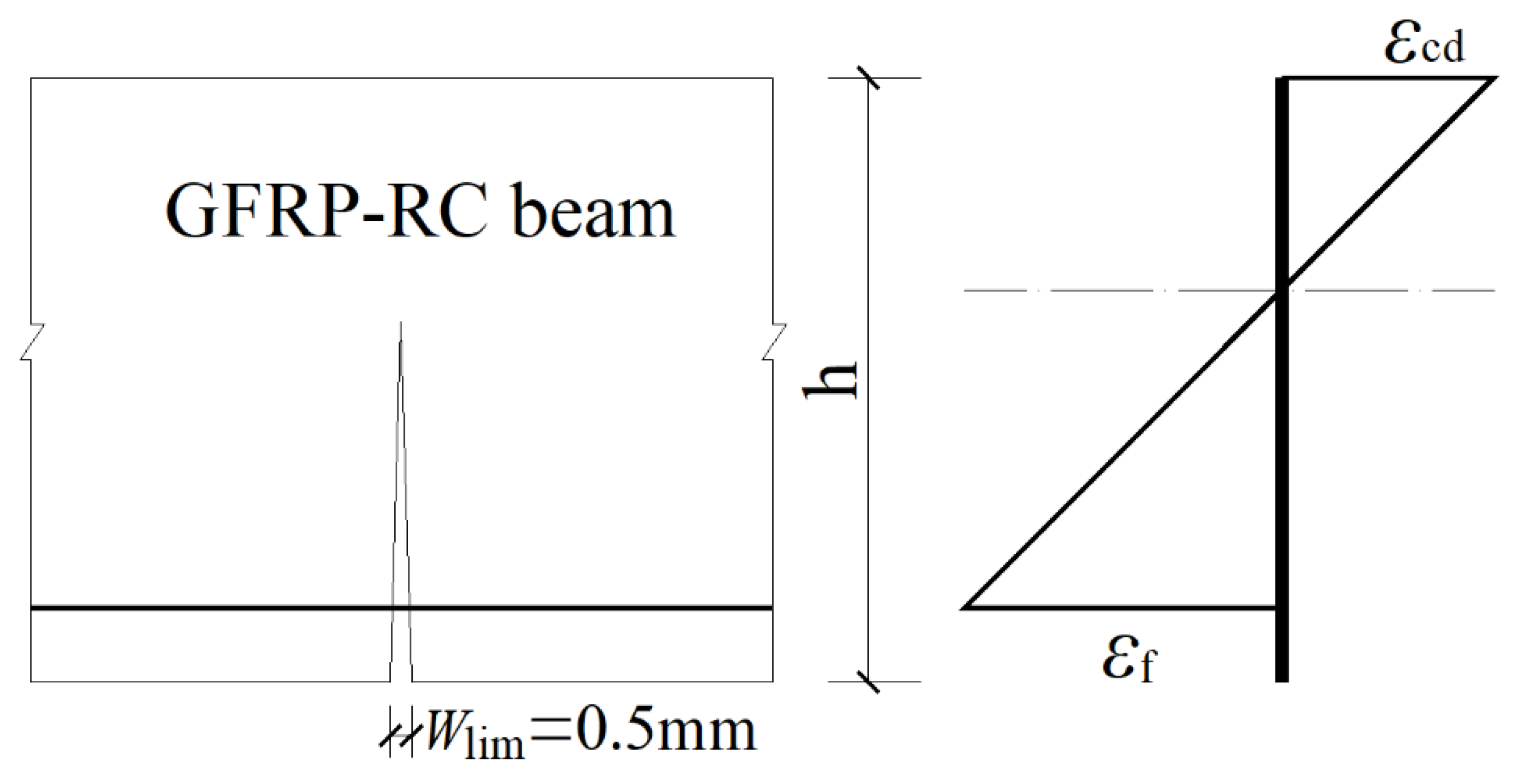






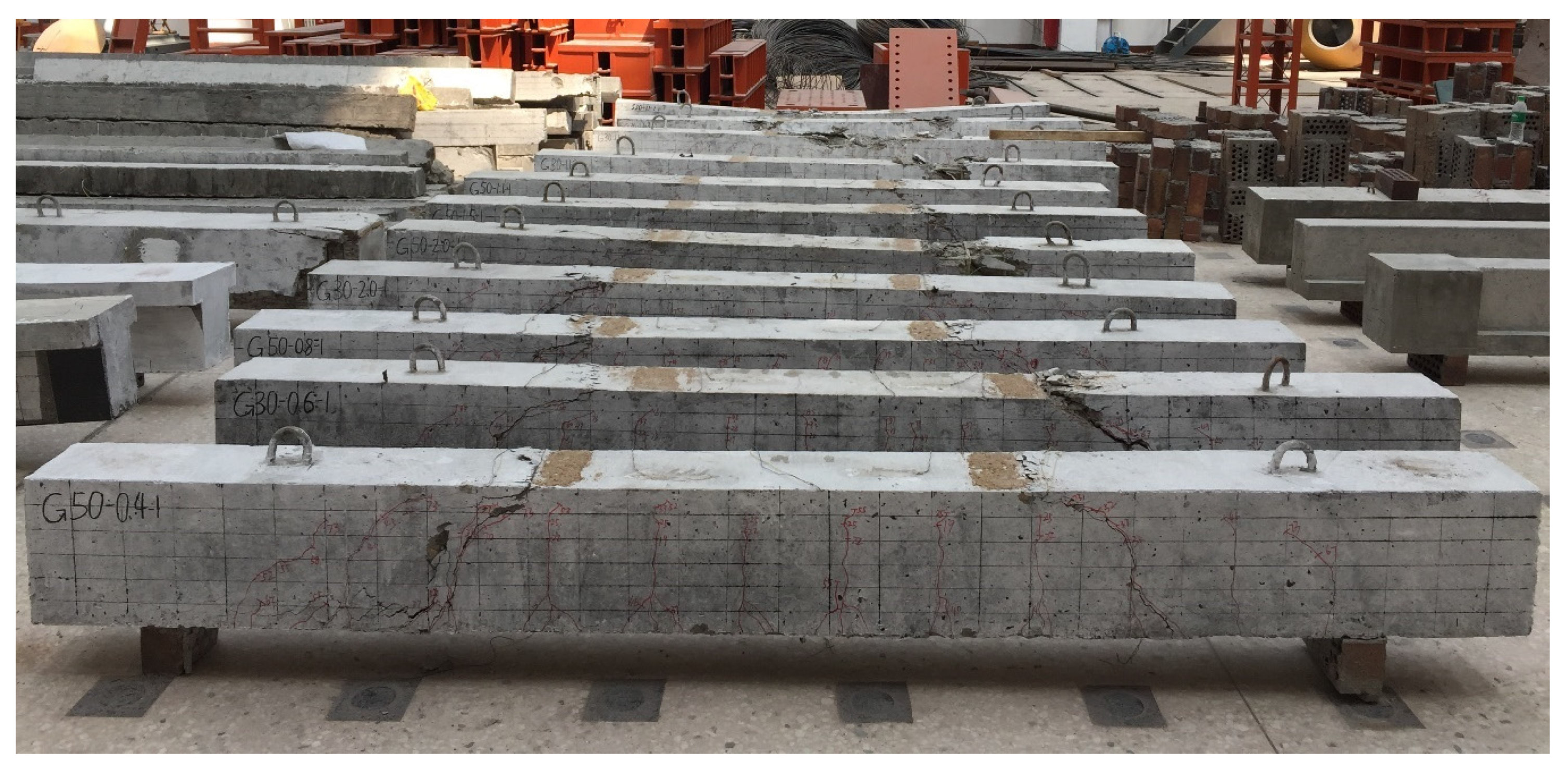
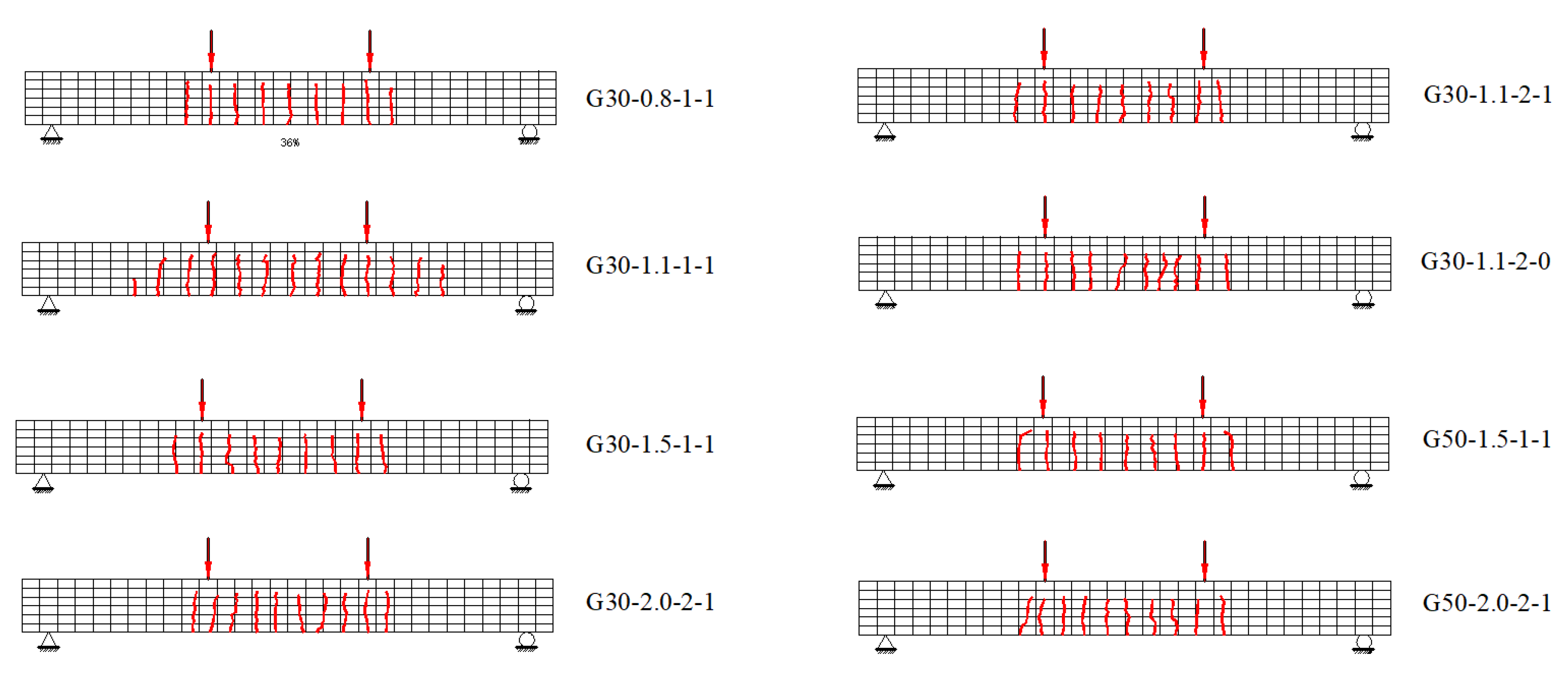
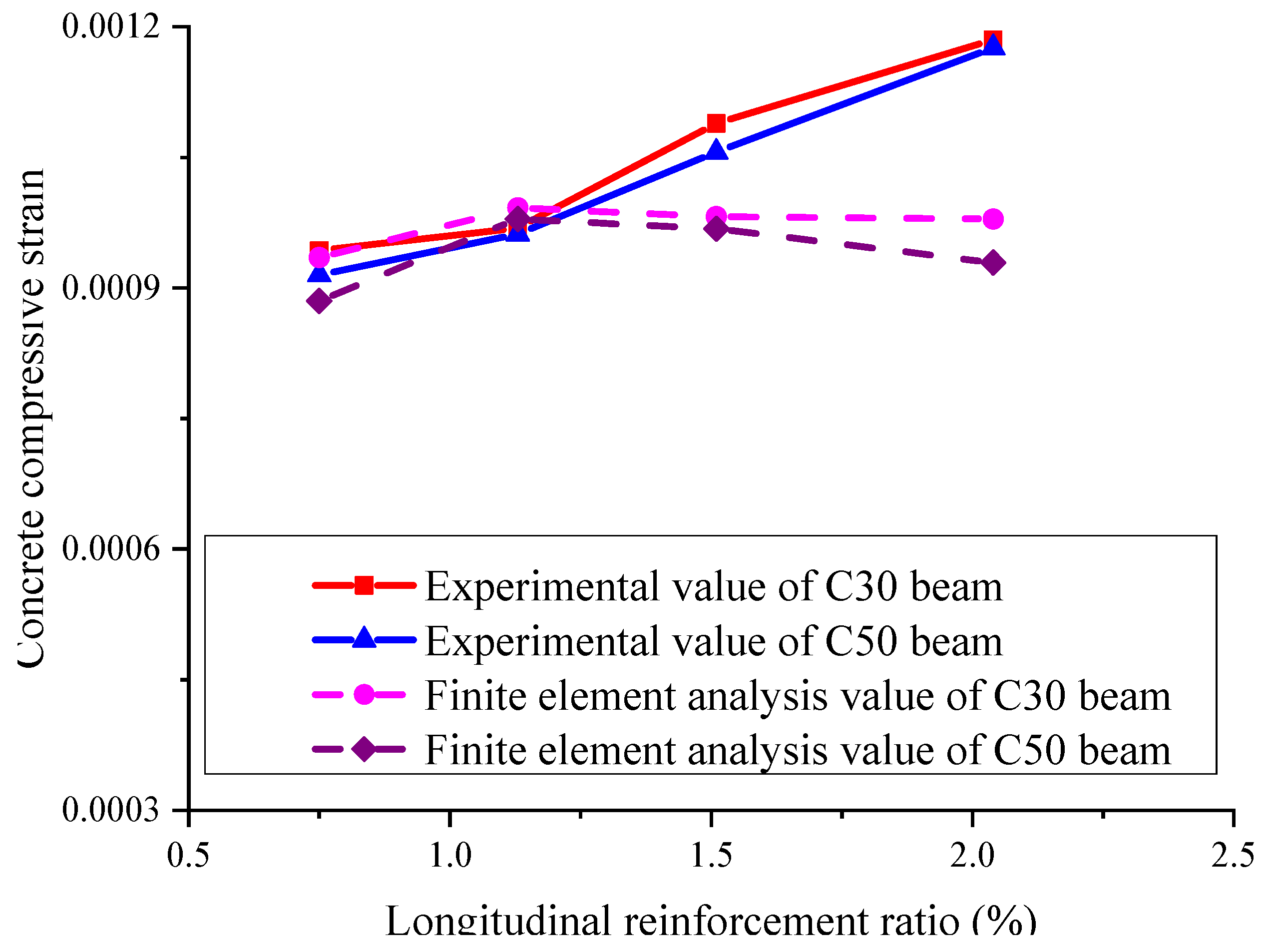
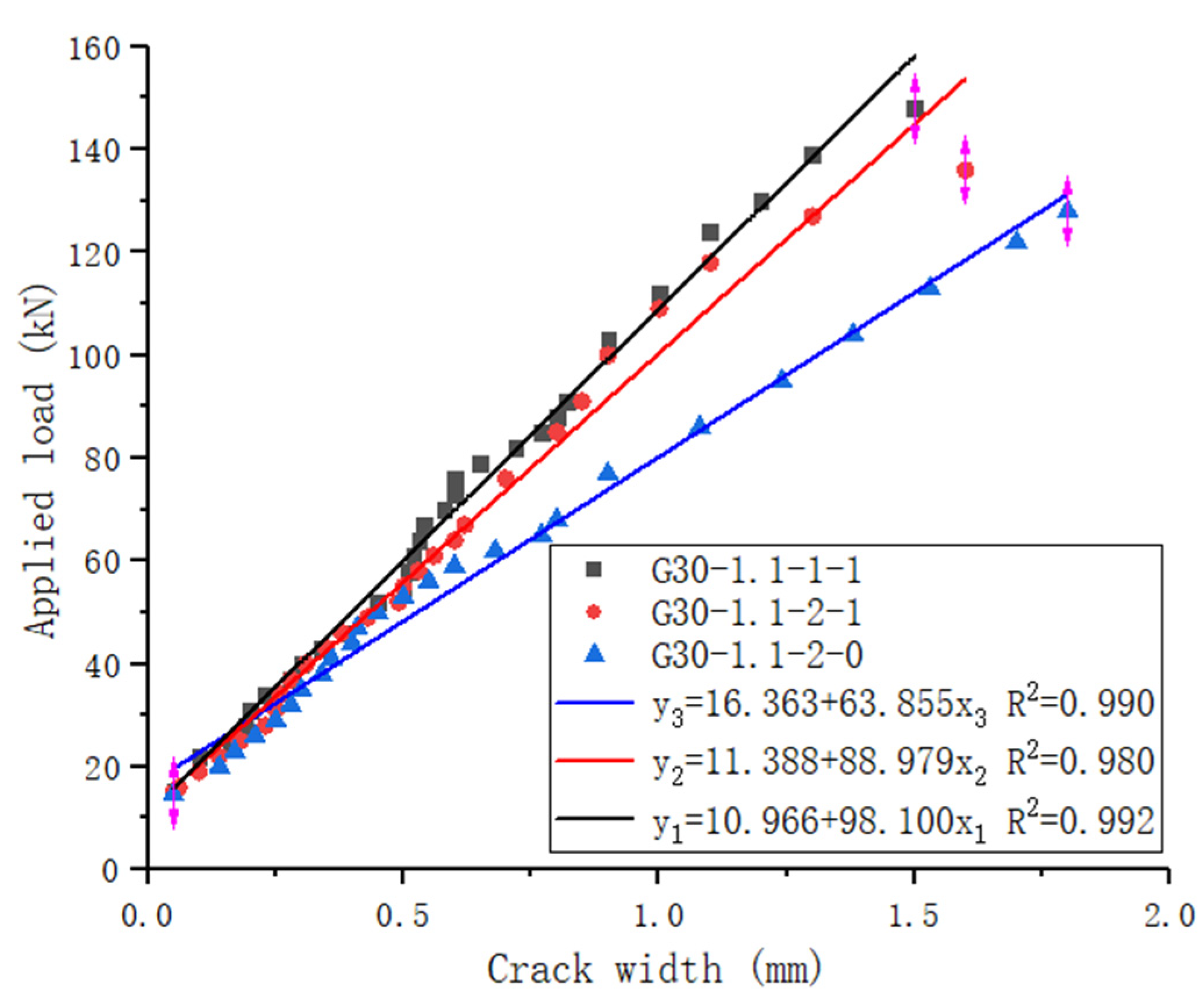
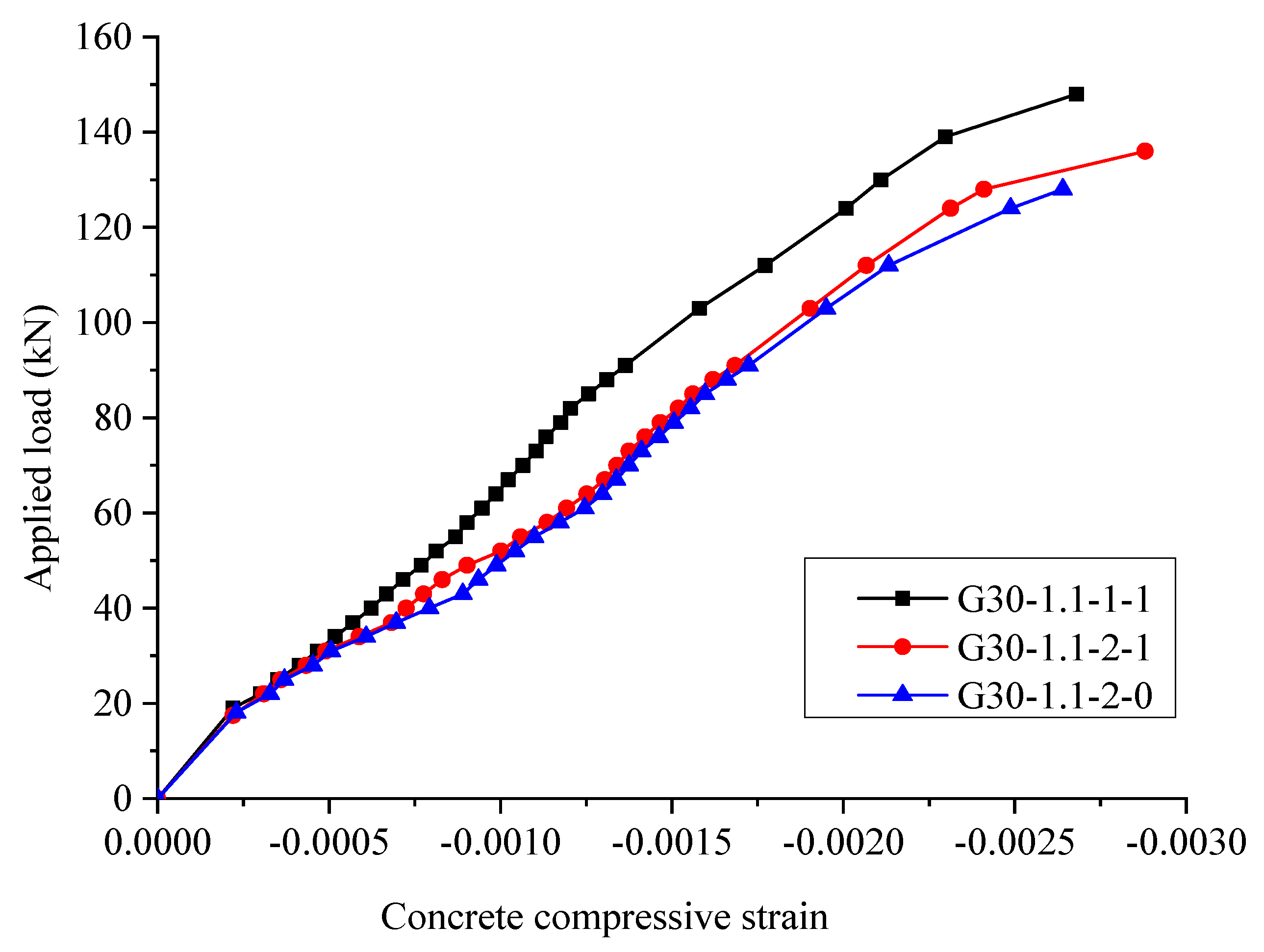
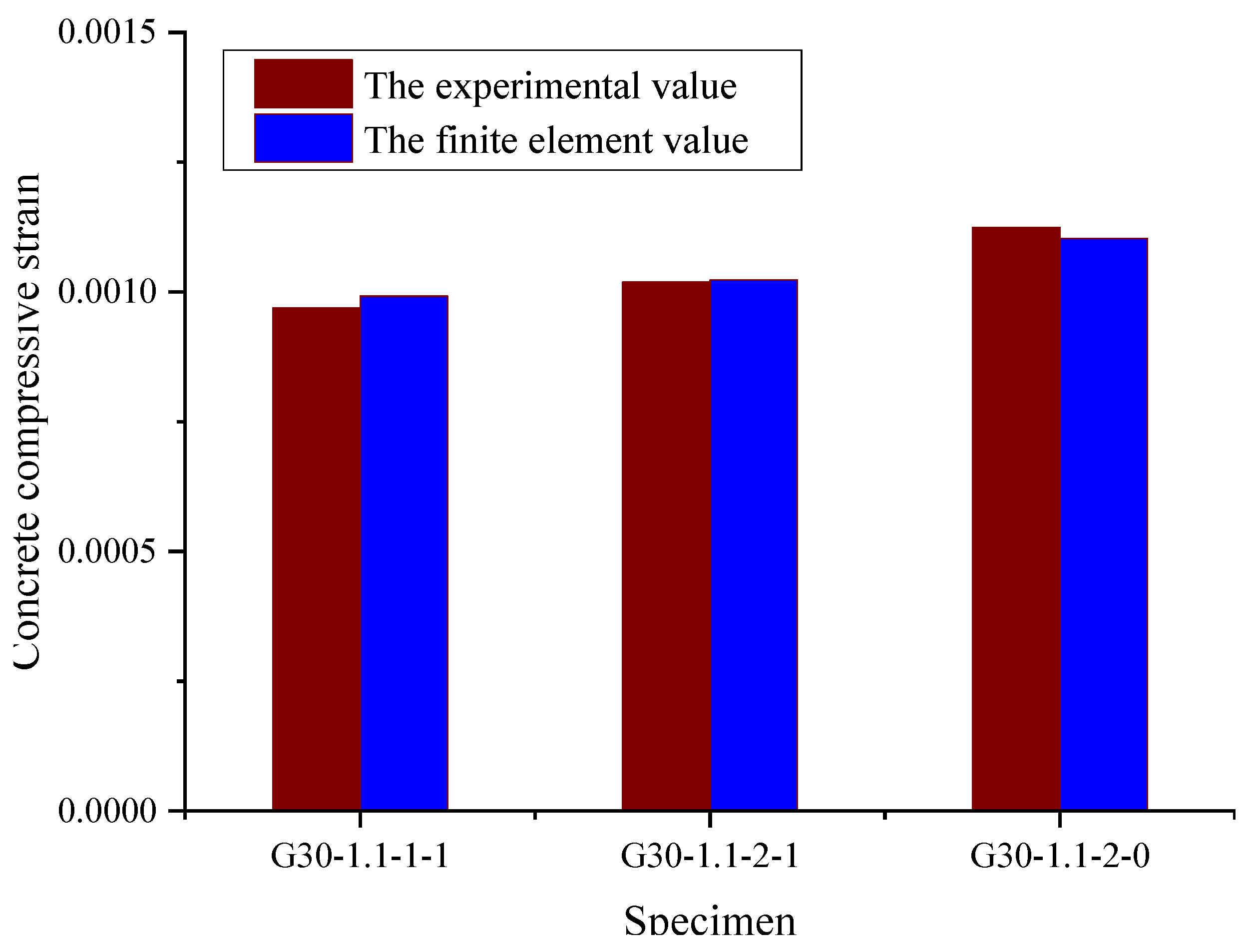
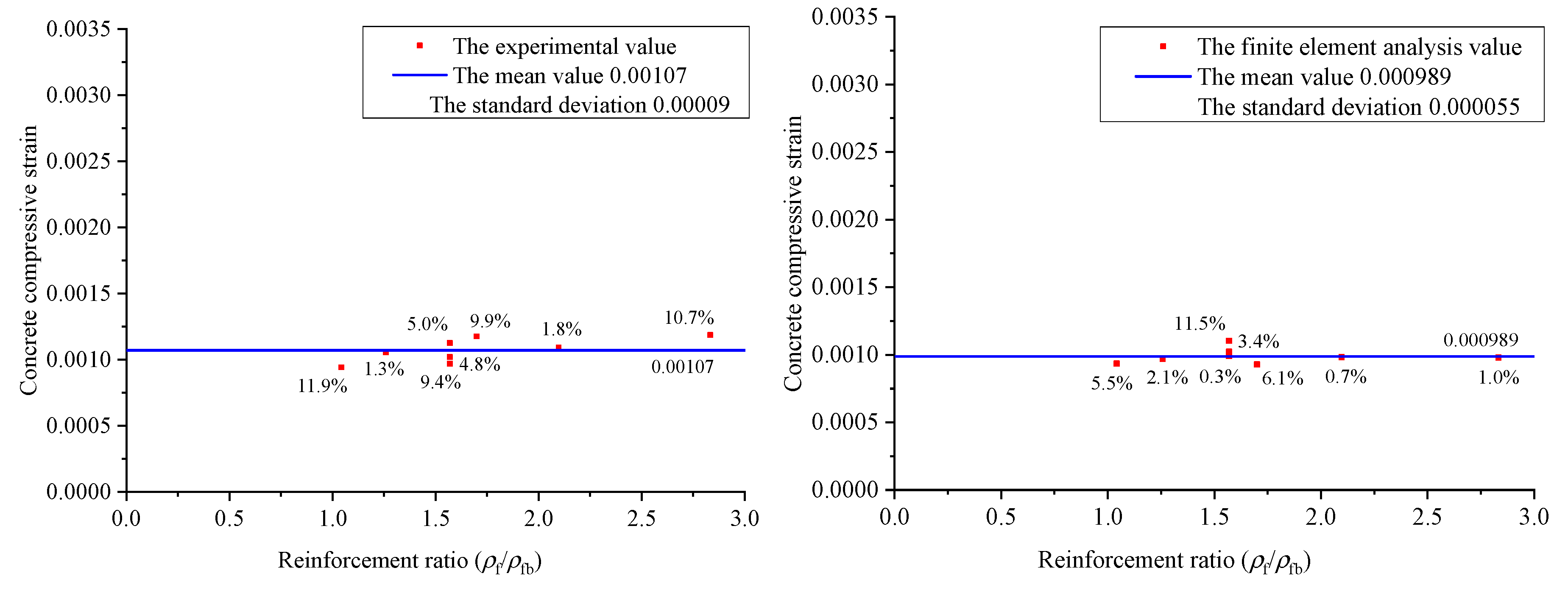

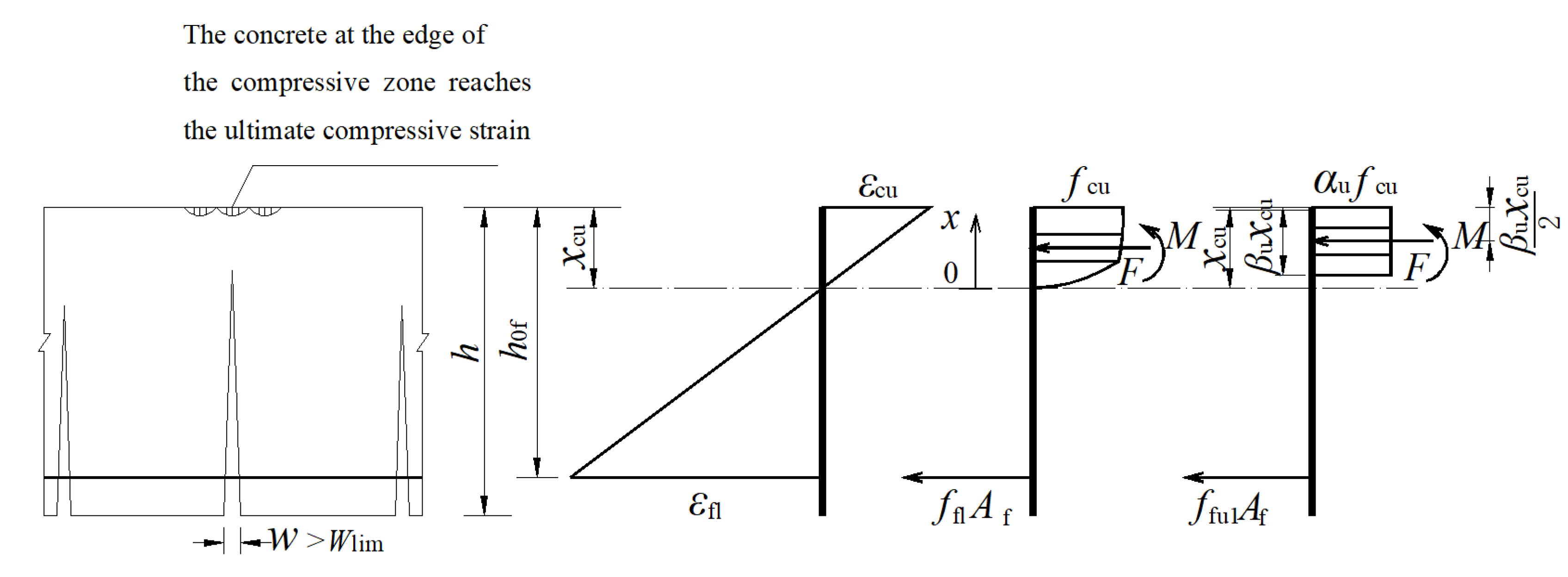
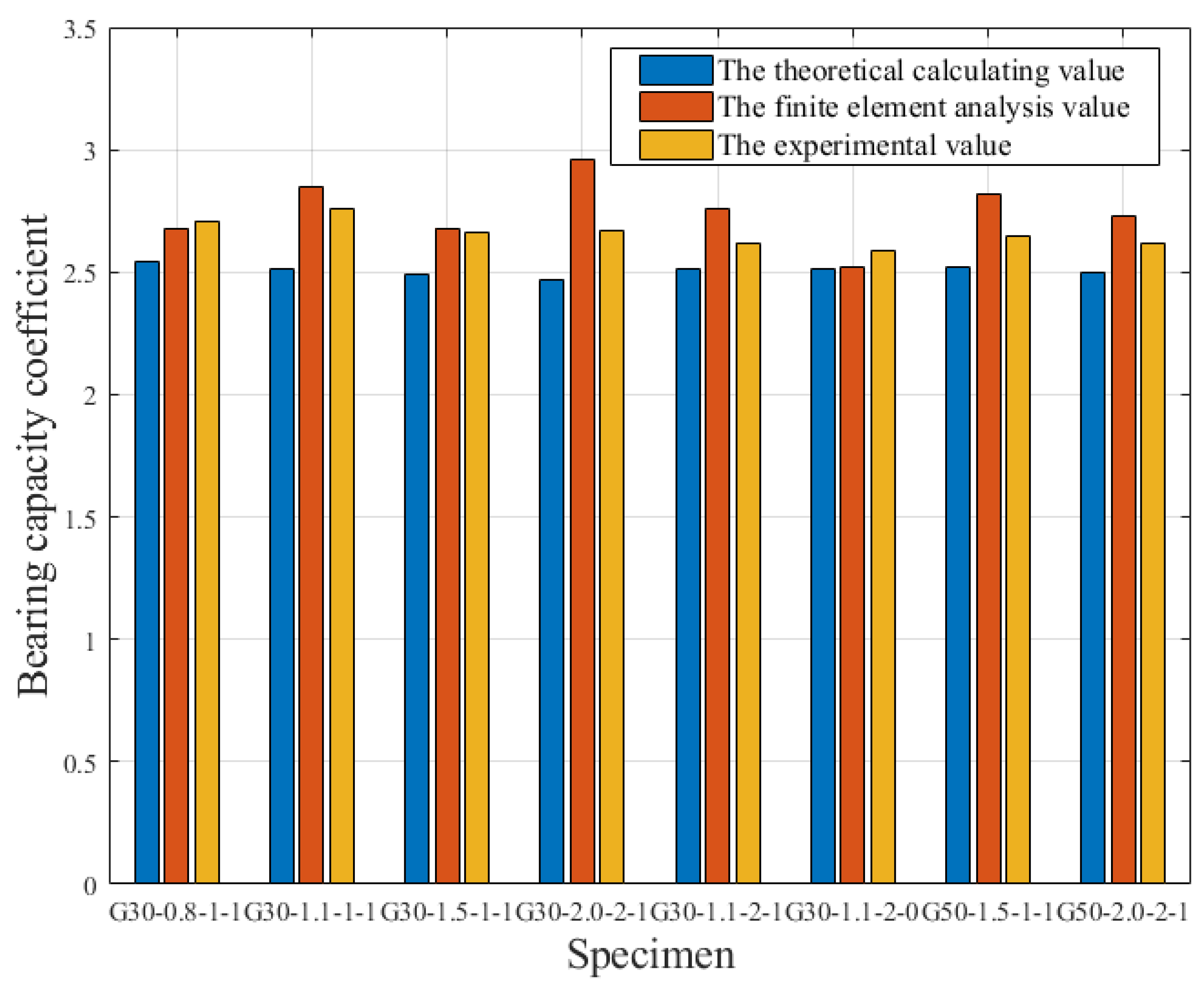
| Specimen | fc | ρfb (%) | Longitudinal Reinforcement | ρf(%) | Stirrups (Two Ends/Pure Bending Section) | h0f (mm) |
|---|---|---|---|---|---|---|
| G30-0.8-1-1 | C30 | 0.72 | 2φ16 | 0.75 | φ12@150/150 | 267 |
| G30-1.1-1-1 | C30 | 0.72 | 3φ16 | 1.13 | φ12@150/150 | 267 |
| G30-1.5-1-1 | C30 | 0.72 | 4φ16 | 1.51 | φ12@150/150 | 267 |
| G30-2.0-2-1 | C30 | 0.72 | 5φ16 | 2.04 | φ12@130/130 | 247 |
| G30-1.1-2-1 | C30 | 0.72 | 5φ12 | 1.13 | φ12@150/150 | 251 |
| G30-1.1-2-0 | C30 | 0.72 | 5φ12 | 1.13 | φ12@150/- | 251 |
| G50-1.5-1-1 | C50 | 1.20 | 4φ16 | 1.51 | φ12@150/150 | 267 |
| G50-2.0-2-1 | C50 | 1.20 | 5φ16 | 2.04 | φ12@130/130 | 247 |
| db (mm) | ffu (MPa) | Ef (GPa) | εfu |
|---|---|---|---|
| 12 | 660 | 44.25 | 0.015 |
| 16 | 578 | 40.69 | 0.014 |
| Specimen | εcd | Wd,ex (mm) | Pd,ex (kN) | Md,ex (kN˙m) | Md,th (kN˙m) | Md,fe (kN˙m) | Md,ex/Md,th | Md,ex/Md,fe |
|---|---|---|---|---|---|---|---|---|
| G30-0.8-1-1 | 0.00094 | 0.52 | 22.16 | 19.94 | 19.78 | 20.79 | 1.01 | 0.96 |
| G30-1.1-1-1 | 0.00096 | 0.50 | 26.80 | 24.12 | 23.46 | 22.32 | 1.03 | 1.08 |
| G30-1.5-1-1 | 0.00109 | 0.40 | 31.90 | 28.71 | 23.36 | 25.86 | 1.23 | 1.11 |
| G30-2.0-2-1 | 0.00119 | 0.30 | 30.76 | 27.68 | 25.35 | 26.23 | 1.09 | 1.06 |
| G30-1.1-2-1 | 0.00102 | 0.49 | 25.96 | 23.36 | 21.45 | 21.28 | 1.09 | 1.10 |
| G30-1.1-2-0 | 0.00112 | 0.45 | 24.76 | 22.28 | 20.45 | 22.26 | 1.09 | 1.00 |
| G50-1.5-1-1 | 0.00106 | 0.40 | 34.56 | 31.10 | 33.44 | 27.83 | 0.93 | 1.12 |
| G50-2.0-2-1 | 0.00118 | 0.36 | 36.30 | 32.67 | 31.35 | 29.65 | 1.04 | 1.10 |
| Average | 1.06 | 1.07 | ||||||
| Standard deviation | 0.08 | 0.05 | ||||||
| Coefficient of variation (COV) (%) | 0.08 | 0.05 |
| Specimen | εcu | Wu,ex (mm) | Pu,ex (kN) | Mu,ex (kN˙m) | Mu,th (kN˙m) | Mu,fe (kNx2D9;m) | Mu,ex/Mu,th | Mu,ex/Mu,fe |
|---|---|---|---|---|---|---|---|---|
| G30-0.8-1-1 | 0.0033 | 1.70 | 60.0 | 54.00 | 50.25 | 52.27 | 1.07 | 1.03 |
| G30-1.1-1-1 | 0.0033 | 1.50 | 74.0 | 66.60 | 58.98 | 61.55 | 1.13 | 1.08 |
| G30-1.5-1-1 | 0.0033 | 1.48 | 85.0 | 76.50 | 65.70 | 68.63 | 1.16 | 1.11 |
| G30-2.0-2-1 | 0.0033 | 1.20 | 82.0 | 73.80 | 62.56 | 65.2 | 1.18 | 1.13 |
| G30-1.1-2-1 | 0.0033 | 1.60 | 68.0 | 61.20 | 53.80 | 56.01 | 1.14 | 1.09 |
| G30-1.1-2-0 | 0.0033 | 1.80 | 64.0 | 57.60 | 53.80 | 56.01 | 1.07 | 1.03 |
| G50-1.5-1-1 | 0.0033 | 2.00 | 91.5 | 82.35 | 81.68 | 85.83 | 1.01 | 0.96 |
| G50-2.0-2-1 | 0.0033 | 1.40 | 95.0 | 85.50 | 78.26 | 82.17 | 1.09 | 1.04 |
| Average | 1.11 | 1.06 | ||||||
| Standard deviation | 0.05 | 0.05 | ||||||
| Coefficient of variation (COV) (%) | 0.05 | 0.05 |
Publisher’s Note: MDPI stays neutral with regard to jurisdictional claims in published maps and institutional affiliations. |
© 2022 by the authors. Licensee MDPI, Basel, Switzerland. This article is an open access article distributed under the terms and conditions of the Creative Commons Attribution (CC BY) license (https://creativecommons.org/licenses/by/4.0/).
Share and Cite
Tu, J.; Zhao, Q.; Gao, K. The Design of Concrete Beams Reinforced with GFRP Bars Based on Crack Width. Materials 2022, 15, 6467. https://doi.org/10.3390/ma15186467
Tu J, Zhao Q, Gao K. The Design of Concrete Beams Reinforced with GFRP Bars Based on Crack Width. Materials. 2022; 15(18):6467. https://doi.org/10.3390/ma15186467
Chicago/Turabian StyleTu, Jianwei, Quan Zhao, and Kui Gao. 2022. "The Design of Concrete Beams Reinforced with GFRP Bars Based on Crack Width" Materials 15, no. 18: 6467. https://doi.org/10.3390/ma15186467
APA StyleTu, J., Zhao, Q., & Gao, K. (2022). The Design of Concrete Beams Reinforced with GFRP Bars Based on Crack Width. Materials, 15(18), 6467. https://doi.org/10.3390/ma15186467





